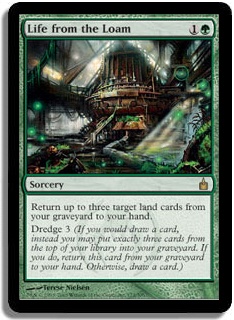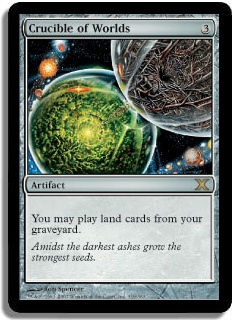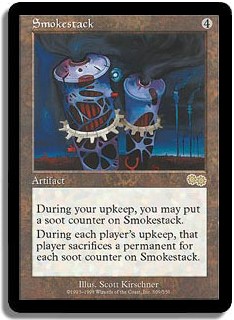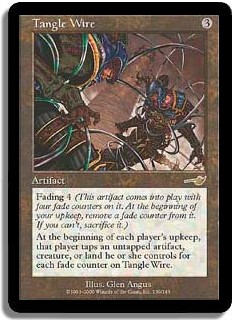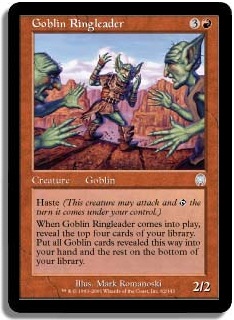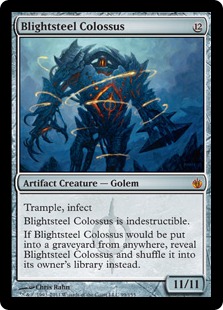In the history of Magic, there have been many cards that are powerful due to their powerful interactions with other cards. Cards like Stoneforge Mystic
and Tolarian Academy have made their mark in Magic’s history due to their dynamic interactions with other cards, making them cornerstones of legendary
decks. Some of these types of cards are able to make the transition from their native format to cube because they are inherently powerful cards, and
others just don’t have the support needed to make them cubeworthy.
Some cards are pretty easy to build around and support in cube. Artifact-based cards like Tolarian Academy and both versions of Tezzeret—his
original Tezzeret the Seeker and Tezzeret, Agent of Bolas forms—perform at their best when used in decks with a lot of artifacts, and while it’ll
be hard to have as many artifacts in a deck as a Constructed Tezzeret, Agent of Bolas deck would have, it’s still not terribly difficult to have enough
artifacts to make him shine in a cube deck. Crystal Shard is a staple in cube because there’s a ton of creatures that trigger when they enter the
battlefield in cube, making supporting Crystal Shard an easy task.
Other such cards that require support aren’t as obvious and are easy to dismiss. A few years ago, I had made this mistake by thinking in the absolute
worst-case scenario for these types of cards. I’ll be discussing some of these cards to give you the tools to critically evaluate the cube worthiness
of these cards so you don’t make that same mistake.
The key is understanding whether there is the critical mass of support for these cards; I’ll start with a pretty easy example.
Life from the Loam/Crucible of Worlds
Both Loam and Crucible have been used in cubes because in cube, there are many ways of putting lands into the graveyard for recursion shenanigans. Many
cubes rightfully don’t include the Onslaught cycling lands (Lonely Sandbar), as they aren’t powerful enough to make the grade in cubes with rares in
them, but that doesn’t render these cards to be weak. Fetchlands, Strip Mine/Wasteland, and manlands are pretty obvious examples of lands that die and
thus can be returned with Life from the Loam, but other things like returning lands discarded to Masticore (all three versions) and Wheel of Fortune as
well as sacrificing lands to Smokestack and Braids, Cabal Minion give Life from the Loam and Crucible a lot of support, making them easy to support in
a cube. There won’t always be a deck that can utilize Life from the Loam or Crucible in a draft, so don’t be disappointed if the support isn’t there in
every draft. However, a deck that can effectively utilize either of these cards should happen once every few drafts, and if the support isn’t there due
to cube size, it may be worth using only one (Life from the Loam due to better interactions with discarding cards) until more support can be given.
(A Few) Tribal Lords
Siege-Gang Commander is an obvious example of a tribal card that doesn’t need help from other Goblins to be amazing, but other less obvious ones,
namely Coralhelm Commander and arguably Graveborn Muse, tend to get evaluated within the context of being “tribal lords.” These types of
cards tend to be dismissed because there isn’t a “Zombie deck” or a “Merfolk deck” in cube, which is a mistake because both
cards are solid even when not interacting with other tribal members!
It’s better to look at Coralhelm Commander as a mini Kargan Dragonlord (that pumps with colorless mana, which is really nice for blue decks that want
to hold counter mana up) and to look at Graveborn Muse as a Phyrexian Arena on a 3/3 body instead of as cards with tribal interactions; those kinds of
interactions are nice but not reasons to play the cards. However, unlike with Loam/Crucible, don’t worry if interactions don’t happen because the cards
don’t require support from other cards to be powerful (but getting a Chameleon Colossus to go with your Graveborn Muse is always nice!).
Stoneforge Mystic
I initially dismissed Stoneforge Mystic as a bad card for cube around the time of Rise of the Eldrazi, as I felt that Stoneforge Mystic was a Squire
with an ability that couldn’t be used effectively. At the time, a lot of the decks that used Stoneforge Mystic like Boss Naya relied on using the 1/2’s synergy with a toolbox of
equipment, and my logic was that, without a toolbox, the Mystic wouldn’t be good enough.
After talking to my friend (and podcast co-host) Anthony Avitollo, I used some quick math and figured out that with the newly previewed Sword of Body
and Mind, there were ten Equipment in my 450-card cube, giving the Mystic roughly one Equipment for every 45 cards in my cube, so I gave her a shot and
found that she did have the required support to make her cubeworthy. While the exact ratio of Equipment to total cards is hard to find, having an
overall ratio of about one Equipment per draft set should easily give Stoneforge Mystic support. Initially, lists were able to jam as much Equipment as
they could into their cubes, but as the precious artifact slots got more competition from other cards in Mirrodin Besieged and New Phyrexia, cube
designers could afford to have powerful equipment like Loxodon Warhammer and Basilisk Collar ride the pine, so even in larger lists, there’s now more
than enough equipment support for Stoneforge Mystic.
Abyssal Persecutor
I had the same initial doubts with Stoneforge Mystic as I had with Abyssal Persecutor—I initially dismissed it because I felt that there wasn’t
enough removal to mitigate its drawback (as well as thinking that a blue mage could counter anything that could kill the Persecutor, but that’s more a
WCSM issue than a perceived lack of support issue).
It’s odd to think of Abyssal Persecutor in the same way as Life from the Loam, but that’s the right way to think of him in cube because both can’t just
be jammed into any deck that could cast it, but the required critical mass of support at the deck level is needed. There’s definitely plenty of removal
in black to off the Persecutor in cube (and recently printed cards like Go for the Throat are welcome additions), but it’s important for people who are
using him in decks to be sure to draft enough removal options to make him leave the party once he’s done his thing. If I had to pick a minimum number
of removal in order to play Persecutor in a deck, I’d say four, and having that amount of removal in a cube deck isn’t out of the ordinary for a cube
deck, making it easy to support Abyssal Persecutor in cube.
Smokestack/Tangle Wire
When many people think of Smokestack and Tangle Wire, they tend to think of Stax decks that lock an opponent out of a very long, drawn-out game. Due to
the fact that Stax decks aren’t really a viable option for cube, people dismiss these cards in cubes. However, people fail to realize that these cards
are excellent cards for aggressive strategies; aggressive decks don’t care about having their mana sources tied up as long as they’re still attacking
for two to win the game. I recently drafted a B/W aggro deck featuring Tangle Wire, Winter Orb, and a horde of efficient cheap attackers, and Tangle
Wire performed wonderfully in that deck.
As cliché as it may sound, for these types of cards, it’s important to think outside the box, realizing all of the uses of cards, and to find
other uses for cards that you may have used in a certain way for years.
Yawgmoth’s Will
Yawgmoth’s Will has been historically used as a centerpiece of Vintage Storm decks that recur cheap spells like Ancestral
Recall, Black Lotus, and Brainstorm to fuel a lethal Tendrils of Agony; people have dismissed the card for cube because these types of storm victories
aren’t possible in cube. While cards like Ancestral Recall will be returned with Yawgmoth’s Will, those recursions won’t be as common, and thankfully,
they aren’t needed to support Yawgmoth’s Will in cube.
Instead of being used as a way to fuel a lethal storm count, Yawgmoth’s Will is typically used as a late-game way to get a burst of card advantage.
Turns like casting a Manic Vandal, returning a Treetop Village, and casting Burst Lightning on something are much more common than the ritual- and
Lotus-fueled stuff of Vintage lore. However, even if it can’t storm an opponent out for the win, it’ll still live up to the Yawg Win nickname most of
the time, making it an excellent cube card.
Now that I’ve covered cubeworthy cards that have the required support to make them good in cube, what about cards that don’t?
As said above, cards like Stoneforge Mystic and Abyssal Persecutor can’t just be jammed into any deck, and decks using them require support to make
them worth using. Cards like the ones mentioned above don’t require too much in the way of support, but the same can’t be said for many of the
“tribal linear” cards like Goblin Ringleader and Goblin Piledriver, due to the fact that there aren’t enough cubeworthy Goblins to achieve
the critical mass to make those extremely linear cards useful; there not only has to be enough Goblins to make a Goblin-focused deck, but there needs
to be the support to make that deck drafted consistently. That isn’t worth the opportunity cost since it forces better red cards out of a cube.
The same can be said about the artifact Colossi (Darksteel Colossus, Blightsteel Colossus), as they are good in the Tinker deck and give a bonus to
those who draft Tinker, but offer little else to a cube, since they’re very weak ramp targets. The interaction is nice, but the overall benefit that
they provide to a cube versus other more overall powerful and versatile cards makes them not worth the cost to use in a cube.
However, it’s not just all about how many cards interact with a card; it’s about overall effect.
Adam Styborski did a post on his common cube blog about Trinket Mage, discussing its overall effect. Someone may initially think, “Well, look at how many targets it has; it has to be good!” But that isn’t
the case because while there is a critical mass of support, number-wise, the overall benefit provided by that toolbox doesn’t make it a very
powerful card in that environment, despite the fact that it’s a tutor at common. (Despite the fact that its targets get better in a powered cube, the
same conclusion can be reached, as its overall benefit isn’t that powerful in that environment.)
The lesson is that you should ask yourself two questions when considering cards that require support: Is there the critical mass required to support
that card? Is the overall benefit provided by that card enough to make it cubeworthy in your cube? Even if you’re not a cube designer and you see a
card like a Totem-Guide Hartebeest staring back at you when you’re drafting your friend’s common cube, you should be asking yourself these same questions!
I hope that this article has given you some insight into some cards that may have appeared to have a lack of support—but do not—in cube.
Like I said earlier, I initially made the mistake of dismissing cards that don’t have a guaranteed effect, and hopefully, this article will prevent you
from doing the same.
May all of your opening packs contain Sol Rings!
@UsmanTheRad
 on Twitter
My blog featuring my cube lists: http://idratherbecubing.wordpress.com
Cube podcast that I and Anthony Avitollo co-host: The Third Power

